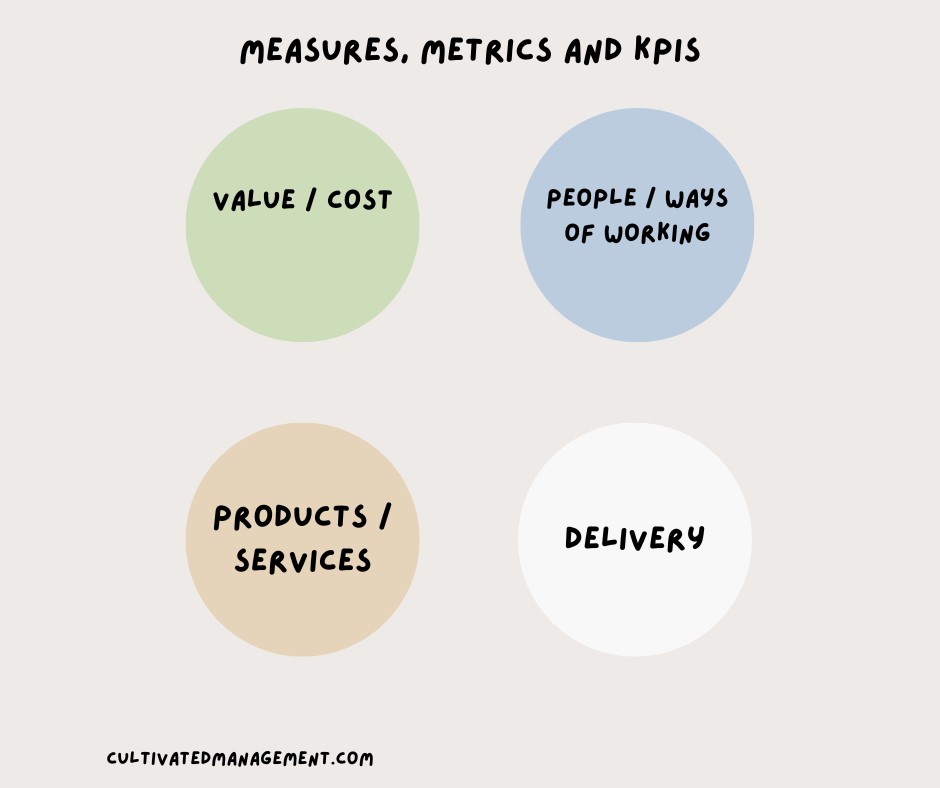
KPIs, Confusion, and the Blending of Measures and Metrics
One of the perennial challenges in organisations is how we deal with measures and metrics. The terminology alone is enough to confuse anyone: OKRs, KPIs, management objectives, scorecards… the list goes on.
We seem to be masters at confusing ourselves in work. On top of that, people often apply certain labels to some activities but not others. It’s common, for example, to see KPIs used to track products or platforms but not to measure people or financial health.
My advice? Keep it simple.
At their core, all measures can be classed as KPIs. Don’t be put off by the jargon. And remember: KPIs don’t have to be purely numerical. Qualitative insights — things that can’t always be neatly reduced to a number — are perfectly valid measures too.
A Key Performance Indicator is simply a measure that matters - something that is important to us. It should help you answer questions like:
- Are we making the business better?
- Are we doing the right things?
- What decisions should we make next?
- Is this a great place to work?
If a measure doesn’t help you answer questions like these, it may not be worth tracking.
Four Categories of KPIs That Matter
I like to group KPIs into four broad categories. And yes — people often miss the one of them entirely; people.

1. Value and Cost
Value is always created outside of the business, so you’ll need a way of measuring it. This usually means sales, revenue, or customer-related metrics.
Costs, by contrast, are everything inside the business. The cost of production, delivery, overheads, salaries. Ideally, costs are less than the value you generate.
👉 Tip: Track these over time. Trends matter far more than single snapshots.
2. Products and Services
You’re almost certainly building or selling something. So how good is it?
Relevant KPIs here might include:
- Reliability and availability
- Ease of use
- Scalability
- Mean time to recover
- Customer ratings
👉 Again, track trends, not one-off numbers.
3. People
This is the category most often forgotten — yet people are the engine of everything. A thriving workplace is the foundation of sustained success.
Potential measures include:
- Team spirit and morale (qualitative feedback counts!)
- Time to hire
- Retention and attrition
- Growth, training, and capability development
👉 If you never measure the human side of the business, you’re missing the heart of long-term performance.
4. Delivery
This is where most businesses focus, often confusing delivery numbers with cost or product quality. But delivery metrics are really about flow.
Some examples:
- How quickly and smoothly are you delivering value?
- Are projects hitting deadlines?
- Are there consistent delays or blockers?
- What is your cycle time?
👉 Cycle time, in particular, is a powerful way of seeing how efficient your processes really are.
Good KPIs Provide Insight, Not Control
One important caveat: KPIs shouldn’t be used to control people. The real test of a good measure is whether it provides insights that help you make the business better.
If it doesn’t do that, it’s waste.
Remember: every measure comes at a cost — definition, tracking, storing, reporting, cleansing. Just because you can measure something doesn’t mean you should.
Focus on what matters, track it over time, and look for patterns in the data. Trends will always tell you more than one-off numbers.
Summary:
- Keep KPIs simple.
- Measure value, cost, products, people, and delivery.
- Focus on insight, not control.
- Pay attention to trends, not snapshots.
When in doubt, ask: Does this measure help me make better decisions (or be compliant with laws)?
If the answer is no, leave it behind.
👉 Ready to move faster towards your business goals while building a workplace people love? I help managers and leaders get there—through coaching, consulting, and training. See how I can help you.
